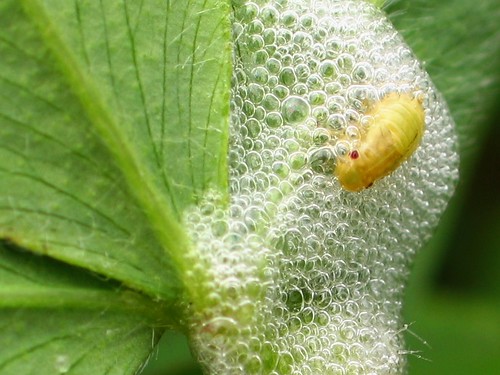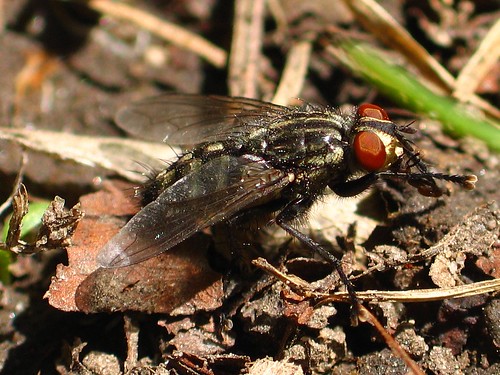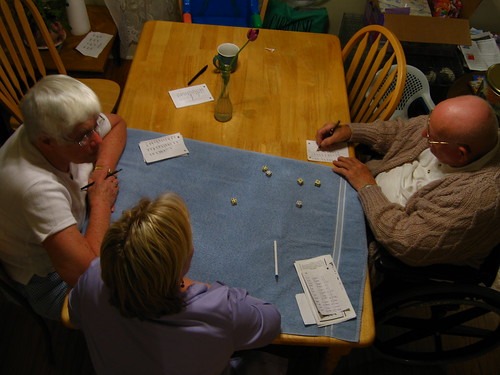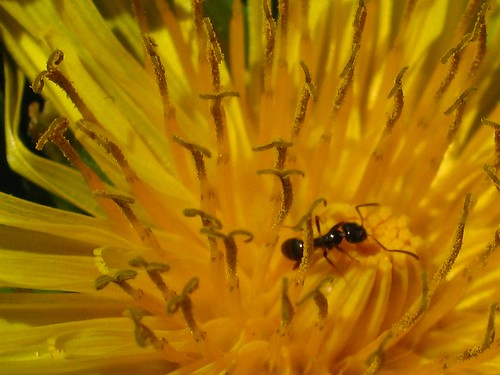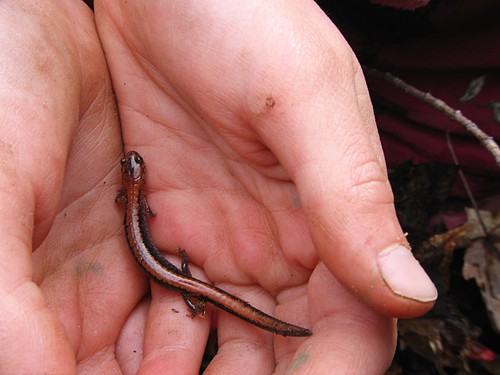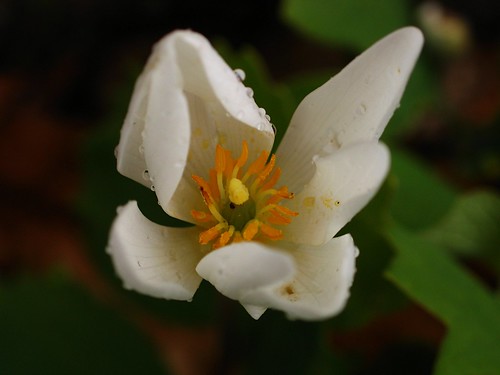Tuesday, May 31, 2005
Make it yourself ring light howto
Also found a nice place to buy loose LEDs as well as to find out how to hook them up, in laymen's terms. Here's another article that has nice links.
A good interview re. Ruby on Rails
Friday, May 27, 2005
Marsman from outer space (Mars)

Ran across this bold Marsman hero while googling my last name. A striking likeness to me, though I prefer black or dark brown boots.
Googled
Ant on peony
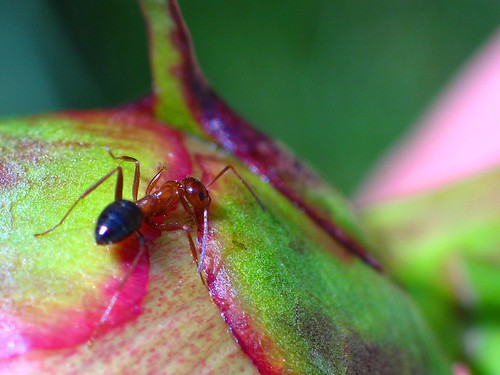
I very much like the colour of the ant and the peony in this picture. I'll be using a polarizing filter soon and am intereseted to see how much I can reduce glare and increase saturation. This picture in particular would benefit from increased saturation of the reds and greens and a reduction in glare such as can be seen at the bottom left corner of this shot.
Spittle bug nymph on clover
Book I'll purchase with gift certificate from my sister
by Dave Thomas (Author), David Heinemeier Hansson (Author)

| List Price: | CDN$ 41.95 |
| Our Price: | CDN$ 29.37 & eligible for FREE Super Saver Shipping on orders over $39. See details |
| You Save: | CDN$ 12.58 (30%) |
This item has not yet been released. You may order it now and we will ship it to you when it arrives.
See larger picture
Book Description
Rails is a full-stack, open-source web framework that enables you to create full-featured, sophisticated web-based applications, but with a twist... A full Rails application probably has less total code than the XML you'd need to configure the same application in other frameworks.
With this book you'll learn how to use ActiveRecord to connect business objects and database tables. No more painful object-relational mapping. Just create your business objects and let Rails do the rest. You'll learn how to use the Action Pack framework to route incoming requests and render pages using easy-to-write templates and components. See how to exploit the Rails service frameworks to send emails, implement web services, and create dynamic, user-centric web-pages using built-in Javascript and Ajax support. There are extensive chapters on testing, deployment, and scaling.
You'll see how easy it is to install Rails using your web server of choice (such as Apache or lighttpd) or using its own included web server. You'll be writing applications that work with your favorite database (MySQL, Oracle, Postgres, and more) in no time at all.
You'll create a complete online store application in the extended tutorial section, so you'll see how a full Rails application is developed---iteratively and rapidly.
Rails strives to honor the Pragmatic Programmer's "DRY Principle" by avoiding the extra work of configuration files and code annotations. You can develop in real-time: make a change, and watch it work immediately.
Forget XML. Everything in Rails, from templates to control flow to business logic, is written in Ruby, the language of choice for programmers who like to get the job done well (and leave work on time for a change).
Rails is the framework of choice for the new generation of Web 2.0 developers. Agile Web Development with Rails is the book for that generation, written by Dave Thomas (Pragmatic Programmer and author of Programming Ruby) and David Heinemeier Hansson, who created Rail
Can't wait to get back into Ruby programming. Now with buzzwords like AJAX (which I actually do have a use for).
Monday, May 16, 2005
Salamander in hand
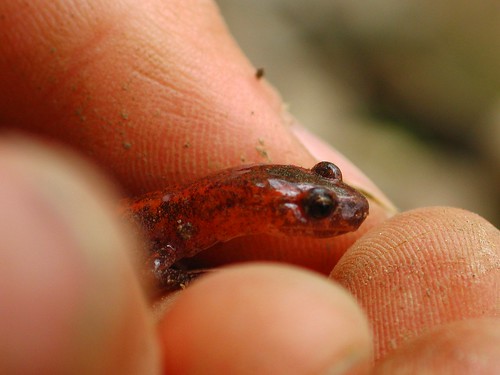
Latin name: Plethodon cinereus
Janneke told me I just had to take a picture of the Eastern Redback Salamander she was holding. It came out rather nicely, with the sense of scale accentuated by the view of the size of Janneke's fingers relative to that of the salamander. Unlike when one photographs a salamander that is standing on the ground, you can see this one's profile and nostrils well.
Spider on fossil
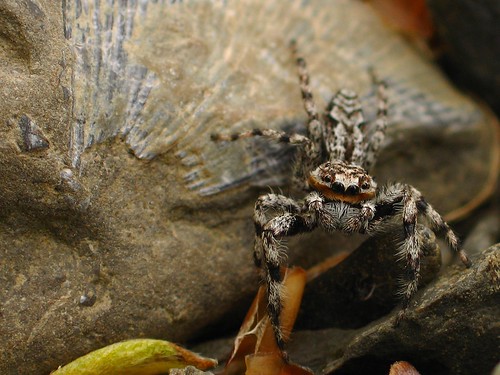
Latin name: unknown
I think this may be a Lynx spider (family Oxyopidae). We went for a looong walk down a limestone creek bed Saturday, all the way to a waterfall where we were able to join up with a trail and get back to the car. This spider was foraging around among the rubble of the creek bed. The fact that he's posing beside a fossil is rather a happy coincidence.
It was not easy to manually focus the camera on this spider. I think that something about the striping, the mix of light and dark hairs, and the patterning of the hairs themselves makes it difficult to judge depth accurately.
Friday, May 13, 2005
Digital camera CCD sensor size de-mystified
| Type | Aspect Ratio | Dia. (mm) | Diagonal | Width | Height |
| 1/3.6" | 4:3 | 7.056 | 5.000 | 4.000 | 3.000 |
| 1/3.2" | 4:3 | 7.938 | 5.680 | 4.536 | 3.416 |
| 1/3" | 4:3 | 8.467 | 6.000 | 4.800 | 3.600 |
| 1/2.7" | 4:3 | 9.407 | 6.721 | 5.371 | 4.035 |
| 1/2.5" | 4:3 | 10.160 | 7.182 | 5.760 | 4.290 |
| 1/2" | 4:3 | 12.700 | 8.000 | 6.400 | 4.800 |
| 1/1.8" | 4:3 | 14.111 | 8.933 | 7.176 | 5.319 |
| 2/3" | 4:3 | 16.933 | 11.000 | 8.800 | 6.600 |
| 1" | 4:3 | 25.400 | 16.000 | 12.800 | 9.600 |
| 4/3" | 4:3 | 33.867 | 22.500 | 18.000 | 13.500 |
| 35 mm film | 3:2 | n/a | 43.300 | 36.000 | 24.000 |
My camera's sensor area is rather small compared to that of a 35 mm film camera. The problem with a small CCD sensor size is that the actual sensors are teeny. This can affect picture quality, leading to noise and dynamic range problems. Wikipedia has a good article on CCD sensors in general.
Here's the approximate size of the CCD sensor in my camera (top) and a 35mm film camera (bottom):
Wikipedia's entry on dynamic range contains the following sentence dealing with this term from a photographic point of view:
Photographers use dynamic range as a synonym for the luminosity range of a scene being photographed; the light sensitivity range of photographic film, paper and digital camera sensors; the opacity range of developed film images; the reflectance range of images on photographic papers.With respect to CCD devices, dynamic range would be the range of luminosity the device could capture. The human eye in general is much better at distinguishing between gradations of luminosity than CCD devices are at capturing them. Thus the disappointment one experiences when a photo doesn't "look like" what one saw. This disappointment is the opposite of the blissful ignorance of the person listening to mp3 audio or viewing an image with an attenuated colour range. In these cases, extra information that the human ear or eye can't discern is thrown out to save space.
Thursday, May 12, 2005
Flesh fly grooming
Useful Wikipedia entry on Linnaean taxonomy
Of note is that the scheme for naming a genus and species pair calls for a capitalized genus name and a lowercase species name (e.g. Viola sororia, the common blue violet). Another thing to note, especially with insects that can have many species for a genus, is that it's acceptable to give the genus name followed by "sp.", indicating that it's an unclassified species for that genus (e.g. Phidippus sp.).
Louis Sr.

I like this picture. My father in law was kind enough to pose for me as I fiddled around with shutter speed and other settings on the camera. No flash used. This results in a bit of fuzziness, but more interesting light effects. Hopefully with more practice I'll be able to reduce fuzziness. I'll probably become more irritating, turning lights on and off and moving people around to get things "just right".
Shooting dice
Making remote scripting less painful
Wednesday, May 11, 2005
Blocking traffic - 11 May, 2005

A UPS guy parks along University Avenue every weekday between 4:30 and 4:45, blocking traffic. This is a non-parking area, and for good reason. Eliminating one lane out of three forces people to stop and route around the truck. Traffic is backed up behind the nearby intersection. Hundreds of people are inconvenienced. Last week I told the city parking guy that the truck is there predictably every day and, in the spirit of the mayor's policy to use parking enforcement to keep traffic flowing, he should ticket the truck every day until the driver stops parking there. The ticket guy was there today and gave me a cheerful greeting. He's probably not used to having such a friendly demeanour displayed toward him while in uniform. We'll see what happens. I've started a photoset on Flickr to track this daily parking violation.
Layout of this blog in IE
Later.... It seems that IE is much less able to cope with big flow issues than Firefox. It was allowing the content region to be expanded to accomodate preformatted text and text wrapping around an image. Firefox seems to rightly allow the offending content to overflow its container while enforcing its container's set dimensions. I can just hear the Microsoft engineers saying "I was only trying to be helpful". The Mozilla people are only trying to be predictable. I prefer the latter. It reduces the problem domain.
Brent ponders
 Brent Ashley, great guy and Curious George in all things, ponders how to deal with comments. Should one leave no-spam up or not. Should one cover one's tracks when one has said something foolish? Apparantly, this is also an issue with others who are plumbing the depths of what it is to be a blogger.
Brent Ashley, great guy and Curious George in all things, ponders how to deal with comments. Should one leave no-spam up or not. Should one cover one's tracks when one has said something foolish? Apparantly, this is also an issue with others who are plumbing the depths of what it is to be a blogger.Blogging is something that has emerged from the confluence of technology and human nature. Given that human nature cannot be boiled down to a handy set of variables shivering nakedly under a microscope, one would expect that blogs would end up being as variable as the wellspring of their birth. It probably won't work to try to herd people into compliance with a set of rules for blogging. Who would listen? Who would care? Perhaps a self-selected group of people who might be under the illusion that their opinion should act as a guide to how things are done. If one aspires to a certain definition of what a blog or what blogging is perhaps one should adhere to such guidelines.
What's probably best is for people to decide for themselves how they want to manage their blogs. I personally like my blog in the way I like a good photograph. It's an aesthetic thing. I'm in the process of waffling over whether to re-enable comments. I like comments for the feedback and to know that I'm not alone, but I'm not really a hard-core journalist.
Flora in city
Tuesday, May 10, 2005
Ants
Because it was there
Monday, May 09, 2005
Female Midge on shed wall
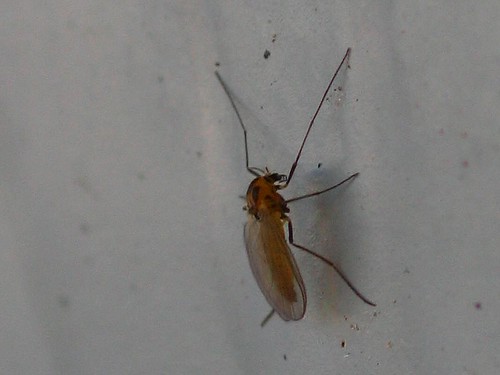
Latin name: Diptera Chironomidae
I think this is a female midge, a match for the male resting on a dandelion flower blogged about earlier. Note, as with the male, the lack of a probiscus, indicating that this midge does not bite. Note also the lack of plumose antennae, a distinction from the male. As with the male, this is identified by class/order only.
This photo suffers from a lack of strong ambient light. Will have to get a better female midge picture.
Ants on dandelion
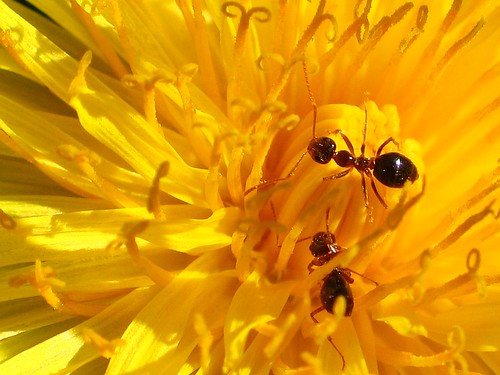
Latin name: Monomorium minimum
Have to find out the species of ant yet and more about what exactly these ants were up to. Something food-oriented for sure [Note: found out this is probably the Little Black Ant]. North America apparantly has about 700 species of ant. Canada has about 100. The safe route may be to avoid identifying by species and stick to class and order or genus when unsure.
Janneke had a good time finding dandelion with ants on them for me. I look forward to getting her a camera when she's old enough. I think she'll take good pictures.
The advantage of having a camera with better focussing, timing and aperture control really shows up in difficult cases like this shot. One needs to be able to control for light intensity variation, focal point, and shutter speed to have any chance of getting a good shot. In this shot the ants are the target but they don't really stand out from the point of view of an autofocus algorithm. The darkness of the ants relative to the brightness and reflectivity of the flower requires good control over exposure time and aperture. With a half-decently still subject I find that I can get more good pictures than before, about one in four or five. With the old camera it was about one in ten or fifteen.
Male Midge on dandelion
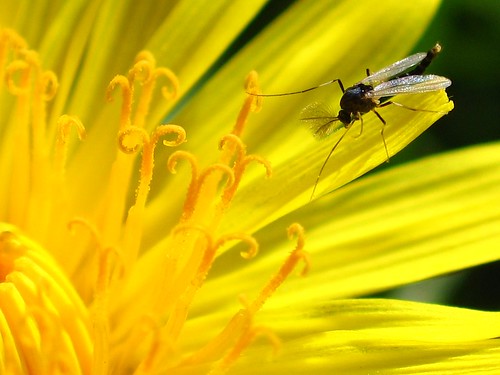
Latin name: Diptera Chironomidae
The new closeup lens is working well/shows promise. Was at a park sans lots of diversity Sunday so had to work with what was there, namely bugs doing things on dandelions. Fortunately the dandelion is brilliantly coloured. We only learn to dislike it after childhood. Am pretty happy with the ability of the A95 to handle a range of shots with the manual shutter speed, arperture, and focus settings. With practise I should be able to take some good pictures.
The latin name given at the top of the midge shown here is Class/Order only. There are apparantly several genus and species branchings from there down. This is a male, as evidenced by the feathery antennae (I imagine for pheremone sensing). This is a non-biting midge. Mosquitos are midges that bite (they have a probiscus).
Common Blue Violet on the side of our driveway

Latin name: Viola sororia
I didn't know that violets grow in North America. As it turns out, there's a lot about violets I didn't know. The African Violet is not really related to North American violets, for one. Also, pansies are in the violet family, you can eat violet leaves in salads as a good source of vitamins A and C and its flowers can be used in jellies. The violet gives off an aromatic ketone, ionine, which temporarily desensitizes nasal receptors, so you only get one sniff. Ionine smells like violets! The Common Blue Violet, pictured here, is hardy and tends to prefer acidic soil. The ones shown here grow at the side of our driveway. They are most welcome. Apparantly, undeveloped flowers produce many many seeds. We'll be collecting them and trying to encourage more growth.
This picture was taken with our Canon A95 on manual setting at f8 at a shutter speed of 1/20th of a second.
Friday, May 06, 2005
docquote
Intelligence is complicated, conditional and hard to measure. The belief that people have "an IQ," however, comes easy. Too easy.
A friend of mine, a Ph.D. with specialties in psychology and statistics, once sat on a plane next to an older woman who had achieved a great deal — and spoke proudly of her five grown children, who were all achievers on their own, holding advanced degrees and honored positions in their professions. The woman credited their success to home schooling.
My friend challenged her on that, saying that heredity must also have something to do with their success. "Yes," the woman replied. "It would if they hadn't all been adopted."
Wednesday, May 04, 2005
Flower lovers
A simple but wonderful perspective of a daisy that not many people would dare try...They also like highly saturated colours it seems, based on the winners.
Rich colours, perfect contrast, wonderful use of empty space, and excellent composition.
Here's a stern warning regarding pictures of flowers gone to seed
Please don't upload photos of flowers that have gone to seed.
Especially Dandelions, when they are white and fluffy they have gone to seed. The flowers are yellow.
Thanks everyone
Better lighting
Tuesday, May 03, 2005
Juan cole blog item on state power
In general, this is my concern in Canadian politics as well. Be it Conservatives or Liberals in power, the Canadian political system is set up to give the party in power a sense of comfortable omnipotence. This is bad. We need to move towards a system where the party in power finds ruling to be a challenging and frustrating experience. The party in power needs to be forced to make deals and compromises and thus become more representative of a broader range of public opinions and ideals. Smaller parties, including "regional" ones, need to be able to have a say in governing. What we now have is stagnation, corruption, public frustration, whining, and generally poor government. Steven Harper does not strike me as a man with new visions. He's power hungry to the point of needing a napkin to sop up his drool. He's shrill. He's evasive. What we need is a person of vision who, once elected, works to reduce the absolute power of the governing party. I don't think a Senate representing the provinces is a good idea, since we already have enough whining between the provinces and federal government. What we need is a system where debate and consensus is the only way to get things done.
Here's a bit from James Madison's Federalist papers
By what means is this object attainable? Evidently by one of two only. Either the existence of the same passion or interest in a majority at the same time must be prevented, or the majority, having such coexistent passion or interest, must be rendered, by their number and local situation, unable to concert and carry into effect schemes of oppression. If the impulse and the opportunity be suffered to coincide, we well know that neither moral nor religious motives can be relied on as an adequate control. They are not found to be such on the injustice and violence of individuals, and lose their efficacy in proportion to the number combined together, that is, in proportion as their efficacy becomes needful.Madison seems to argue for checks and balances aimed to prevent the majority from acting in tyrrany. As someone with a healthy belief in total depravity over humanism I concur. I don't concur with all he wrote, though. Some of it seems kind of flaky, though 200 years can do that.From this view of the subject it may be concluded that a pure democracy, by which I mean a society consisting of a small number of citizens, who assemble and administer the government in person, can admit of no cure for the mischiefs of faction. A common passion or interest will, in almost every case, be felt by a majority of the whole; a communication and concert result from the form of government itself; and there is nothing to check the inducements to sacrifice the weaker party or an obnoxious individual. Hence it is that such democracies have ever been spectacles of turbulence and contention; have ever been found incompatible with personal security or the rights of property; and have in general been as short in their lives as they have been violent in their deaths. Theoretic politicians, who have patronized this species of government, have erroneously supposed that by reducing mankind to a perfect equality in their political rights, they would, at the same time, be perfectly equalized and assimilated in their possessions, their opinions, and their passions.
Conflagration
Comments
Doc on Dave Winer
Monday, May 02, 2005
Bloodroot
Closeup of Bloodroot
The Canon A95
Yesterday at the park the weather was quite overcast to the point of having heavyish rain at the end of our outing. Overcast weather can sometimes give you shots that are less washed out, but the extent of the cloud cover yesterday meant that light intensity was reduced somewhat more than is optimal. However, I decided yesterday to try out the fully manual mode that the A95 offers. The camera does a great job of giving feedback in the lcd viewscreen in real time on how dark or light your end shot will be. If you open the aperture too much you'll see a washed out viewscreen and vice versa. This allowed me to quickly experiment with aperture and shutter speeds to get the shots I wanted. Decreasing aperture has the desirable effect of increasing depth of field but also decreases the amount of light reaching the sensor, leading to the requirement of increasing shutter speed. I found a good set of aperture (f-stop) and shutter speeds that I could use to give me good colour and light intensity range while still avoiding blurring from camera shake and a depth of field that was too limited.
Overall, being able to manually set aperture and shutter speed let me produce much better shots than with fully or partially automatic settings. When I'm taking several shots under similar lighting conditions I think I'll go all manual from now on.
Eastern Redback Salamander in leaf litter

I was St. John's conservation area with the kids again yesterday. We had a great time and found a relatively exotic creature, a salamander! Apparantly, these salamanders can live ten years or more. We looked under logs on the slope of hills and eventually fount two. When we were finished looking we let them go.
For this shot I used my new Raynox DCR 250 closeup lens. It's a 10x achromatic (meaning it produces white light across the lens) closeup lens designed especially for getting good shots of a small area. When the camera's lens is zoomed out to full focal length it can focus on an area about 3 cm square. For this shot I had to zoom out less. You can see the reduce depth of field which is the partial result of the increased aperture I needed to use in this shaded area of the woods on a heavily overcast day. What I did really appreciate is that the Canon A95 allows you to set where to focus by moving a little focus square around the lcd viewscreen. I set it to focus on the salamander's head and it worked great.
